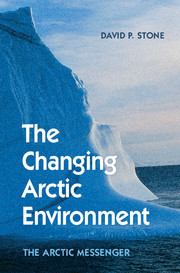Description
The Changing Arctic Environment
The Arctic Messenger
Author: Stone David P.
An accessible, engagingly written book on Arctic environmental change and cooperation by an author intimately involved in Arctic science and policy.
Language: English
Subjects for The Changing Arctic Environment:
Publication date: 02-2015
374 p. · 15.7x23.5 cm · Hardback
374 p. · 15.7x23.5 cm · Hardback
Description
/li>Contents
/li>Biography
/li>
This accessible and engagingly written book describes how national and international scientific monitoring programmes brought to light our present understanding of Arctic environmental change, and how these research results were successfully used to achieve international legal actions to lessen some of the environmental impacts. David P. Stone was intimately involved in many of these scientific and political activities. He tells a powerful story, using the metaphor of the 'Arctic Messenger' - an imaginary being warning us all of the folly of ignoring Arctic environmental change. This book will be of great interest to anyone concerned about the fate of the Arctic, including lifelong learners interested in the Arctic and the natural environment generally; students studying environmental science and policy; researchers of circumpolar studies, indigenous peoples, national and international environmental management, and environmental law; and policymakers and industry professionals looking to protect (or exploit) Arctic resources.
1. Personal beginnings; Part I. The Changing Arctic: 2. The Arctic messenger; Part II. Working Together: 3. The Arctic messenger gains a voice: the Arctic Monitoring and Assessment Programme; Part III. What Is the Present State of Knowledge?: 4. Radioactivity; 5. Heroic efforts; 6. Acidification and Arctic haze; 7. Stratospheric ozone depletion; 8. Persistent organic pollutants and heavy metals (including mercury); 9. Conducting marine science in the Arctic; 10. Climate change in the Arctic; Part IV. What Does This All Mean?: 11. Thoughts on education, the training of Arctic scientists and Arctic research; 12. The long and short of it: has the Arctic message been noticed?; 13. Epilogue: keeping the Rovaniemi flame alive.
David P. Stone received a degree in zoology from the University of Aberdeen in 1973. In 1977, he earned a PhD in oceanography from the University of British Columbia. Initially, he worked as an oceanographic scientist in the Canadian Arctic. From 1980 to 2004, he was involved in the management of research for the Northern Affairs Programme of the Canadian Government, becoming Director of Northern Science and Contaminant Research. During this time, he became involved in the development of circumpolar cooperation under the Arctic Environmental Protection Strategy that subsequently became the Arctic Council. In 1991 they established the Arctic Monitoring Assessment Programme (AMAP), where he served as Canada's delegate on the governing working group until 2004 and as its chair between 1993 and 1997. From 1990 to 1994, David co-chaired the task force on persistent organic pollutants (POPs) under the UNECE LRTAP Convention and helped develop a legally binding protocol under the convention. He also served on the Canadian delegation that negotiated a parallel protocol on heavy metals, including mercury. He was involved with negotiating the Stockholm Convention on POPs and, after retirement, he was retained by the convention secretariat to assist in the development of a process to measure, through global monitoring, whether environmental levels of POPs are falling as a result of the new international controls. In 1997, he was instrumental in developing a virtual University of the Arctic based on existing circumpolar institutions. The Arctic Council formally announced the creation of the university in September 1998. David received Deputy Minister awards from the Northern Affairs Programme and from Environment Canada, and he also received an award from Jean Chrétien, the then Prime Minister of Canada. These awards were in recognition of his work on developing and managing Arctic contaminants research and on using the results to achieve negotiation of global agreements.
© 2024 LAVOISIER S.A.S.



